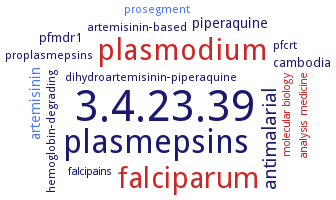3.4.23.39: plasmepsin II
This is an abbreviated version!
For detailed information about plasmepsin II, go to the full flat file.

Word Map on EC 3.4.23.39 
-
3.4.23.39
-
plasmepsins
-
plasmodium
-
falciparum
-
antimalarial
-
piperaquine
-
artemisinin
-
pfmdr1
-
cambodia
-
proplasmepsins
-
hemoglobin-degrading
-
pfcrt
-
artemisinin-based
-
dihydroartemisinin-piperaquine
-
prosegment
-
molecular biology
-
falcipains
-
analysis
-
medicine
- 3.4.23.39
-
plasmepsins
- plasmodium
- falciparum
-
antimalarial
-
piperaquine
- artemisinin
-
pfmdr1
-
cambodia
-
proplasmepsins
-
hemoglobin-degrading
-
pfcrt
-
artemisinin-based
-
dihydroartemisinin-piperaquine
- prosegment
- molecular biology
-
falcipains
- analysis
- medicine
Reaction
Hydrolysis of the bonds linking certain hydrophobic residues in hemoglobin or globin. Also cleaves the small molecule substrates such as Ala-Leu-Glu-Arg-Thr-Phe!Phe(NO2)-Ser-Phe-Pro-Thr =
Synonyms
AH II, aspartic hemoglobinase II, malarial aspartic protease, PFAPD, pfpm2, plasmepsin 2, plasmepsin II, PLm II, PLMII, PM II, PMII, PSM2
ECTree
Advanced search results
Crystallization
Crystallization on EC 3.4.23.39 - plasmepsin II
Please wait a moment until all data is loaded. This message will disappear when all data is loaded.
crystal structure of Met205Ser mutant enzyme in complex with the two inhibitors rs367 and rs370, crystals are grown at 293 K by vapor diffusion in hanging drops
crystal structure of uncomplexed plasmepsin II as well as the complex with the potent inhibitor EH58, crystals are grown at 20°C by vapor diffusion in hanging drops
-
crystal structures of Plm II, uncomplexed and in complex with different inhibitors, reveal considerable conformational flexibility
-
generation of 3D-QSAR pharmacophore models for binding of PlmII inhibitors. A series of 26 inhibitors were modeled in the binding clefts of the PlmII and human cathepsin D to establish QSAR models of the proteases inhibition. The contributions of the P2 and P3' residues to the inhibitors binding affinity are responsible for the target selectivity
-
hanging drop method, X-ray structure of plasmepsin II complexed with the potent non-peptidomimetic achiral inhibitor at 1.6 A
-
in complex with inhibitors, sitting drop vapor diffusion method, using either 0.1 M HEPES pH 7.5 and 1.4 M sodium citrate tribasic dihydrate or 0.2 M lithium sulfate, 1.26 M ammonium sulfate, 0.1 M Tris pH 8.5
-
ligand docking studies with plasmepsin II predict binding of benzimidazole compounds at the center of the extended substrate-binding cleft. According to the plausible mode of binding,the pyridine ring of benzimidazole compounds interact with S1' subsite residues whereas the acetophenone moiety is in contact with S1-S3 subsites of plasmepsin II active center
-
molecular dynamics simulation using inhibitor (R)-N-[(1S,2R)-2-Hydroxyindan-1-yl]-3-[(2S,3S)-3-(2,6-dimethyl-4-(pyridine-4-ylmethyl)amino-phenoxyacetyl)amino-2-hydroxy-4-phenylbutanoyl]-5,5-dimethyl-1,3-thiazolidine-4-carboxamide
-
plasmepsin II in complex with inhibitor N-[(1S)-1-([(1S,2S)-1-([(4-bromobenzyl)oxy]methyl)-4-([(1S)-2-([(1S)-1-carbamoylbutyl]amino)-2-hydroxy-1-methylethyl]amino)-2-hydroxy-4-oxobutyl]carbamoyl)-2-methylpropyl]-4,5-dihydropyridine-2-carboxamide
-
sequence and structural analysis combined with molecular dynamics simulations to predict the functional residues. Residues Y17, V105, T108, L191, L242, Q275, and T298 are important for plasmepsin function. Residues V105 and T108 are localized in a flap of an interior pocket. There is a rapid conformational change in the L3 region of plasmepsins that closes the active site
the aspartic acid residues in structure PDB 1lfA is noncoplanar. The catalytic water molecule is present, but the plane of the carboxylate group of Asp214 is rotated by 66° from its original position
-


 results (
results ( results (
results ( top
top





